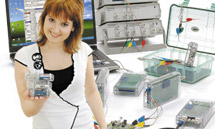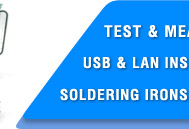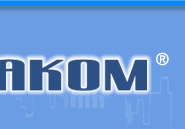|
|
ASE-4211 Multifunctional Soldering Station
ASE-4211 Multifunctional Soldering Station
|
|
AKTAKOM ASE-4211 multifunctional soldering station combines two channels in one housing: soldering and desoldering (hot air). Station: Power consumption: 800 W. Fast heating. LCD showing soldering and desoldering temperatures. Digital calibration of temperature. Smart auto sleep mode to save energy and extend heating element life. Soldering iron: Power 70 W. Soldering iron heating temperature adjustment: 100…480 °C / 212…896 °F. Temperature stability ±2 °C. Hot air gun: Power 730 W. Temperature range 100...500 °C / 212…932 °F. Smoothly adjustable brushless fan.
|
|
AKTAKOM ASE-4211 multifunctional soldering station combines two channels in one housing: soldering and desoldering (hot air), which makes it a convenient and practical solution for soldering various electronic components (including SMD) in production and repair works.
ASE-4211 soldering station is also equipped with smart cooling system with auto power off.
Specifications
Station:
- Power consumption: 800 W
- Compact dimensions: 2 stations in one housing
- Fast heating
- LCD showing soldering and desoldering temperatures
- Digital calibration of temperature
- Smart auto sleep mode to save energy and extend heating element life
- All-metal heater design ensures safety and long-lasting low voltage operation
- Full metal stand
- Power supply voltage: 220…240 V, 50 Hz
- Overall dimensions 98×170×151 mm
- Weight 2.6 kg
Soldering iron:
- Power 70 W
- Soldering iron heating temperature adjustment: 100…480 °C / 212…896 °F
- Temperature stability ±2 °C
- Ceramic heating element
- Resistance between tip and ground <2 Ω
- Tip potential to ground: <2 mV
Hot air gun:
- Power 730 W
- Temperature range 100...500 °C / 212…932 °F
- Smoothly adjustable brushless fan
- Flow rate 30 l/min (max.)
- Temperature stability ±5 °C
Standard accessories
- Soldering station
- Soldering iron with tip
- Hot air gun
- Power cable
- Soldering iron holder
- Hot air gun holder (with mounting on the body)
- Wrench
| ASE-4211 Multifunctional Soldering Station - Front panel |
|
|
| ASE-4211 Multifunctional Soldering Station - Rear panel |
|
|
| ASE-4211 Multifunctional Soldering Station - Soldering iron |
|
|
|
| ASE-4211 Multifunctional Soldering Station - Hot air gun holder |
|
|
| ASE-4211 Multifunctional Soldering Station - Soldering iron holder |
|
|
| ASE-4211 Multifunctional Soldering Station - Nozzles |
|
|
|
| ASE-4211 Multifunctional Soldering Station - Wrench |
|
|
| ASE-4211 Multifunctional Soldering Station - Side view |
|
|
Safety instructions
Take care of yourself!
- Please read user manual carefully before using the instrument.
- Do not use the device if there is visible damage.
- Repair and maintenance of the device can be done only by a qualified specialist of the service center.
- Before connecting the instrument to the electrical network, observe all known precautions, and make sure that the grounding system is to avoid electric shock.
- Use only those accessories that are intended for use with this device.
- While working, do not touch the metal parts near the tip of the soldering iron.
- After completion of the work, it is necessary to install the soldering gun in the regular holder of the soldering gun.
Frequently Asked Questions
What temperature should use for soldering?
The rework station is not functioning, turns on, but not blowing air?
Why a "de-tinned" tip fails to work?
How to clean the tip?
How to care and use of the soldering tip?
| What temperature should use for soldering? |
600°- 650°F (316°- 343°C) is a good place to start for lead-based solder and 650°- 700°F (343°- 371°C) for lead-free solder.
Note: if clots form, the temperature is too low.
Up
|
| The rework station is not functioning, turns on, but not blowing air? |
The most common reason the rework station not functioning - the handle is placed on its holder. After the handle is placed on the holder the soldering station goes into standby mode and is ready for the working mode. Please follow user's manual for more details.
Up
|
| Why a "de-tinned" tip fails to work? |
|
A de-tinned tip is one which cannot wet with solder. This exposes the plating to oxidation and degrades the heat transfer efficiency of the tip.
The de-tinning is caused by:
1) Failure to keep the tip covered with fresh solder while not in use.
2) High tip temperatures.
3) Insufficient melting in soldering operations.
4) Wiping the tip on dirty or dry sponges and rags (Always use a clean, wet, industrial grade, sulfur-free sponge).
5) Impurities in the solder, iron plating, or on the surfaces to be soldered.
Up
|
| How to clean the tip? |
|
Caution! Never file the tip to remove oxide.
- Set the temperature to 250°C.
- When the temperature stabilizes, clean the tip with the cleaning sponge and check the condition of the tip.
- If there is black oxide on the solder-plated portion of the tip, apply new solder (containing flux) and wipe the tip on the cleaning sponge. Repeat until the oxide is completely removed. Coat with new solder. The solder protects the tip from oxidation and prolongs the life of the tip.
- If the tip is deformed or heavily eroded, replace it with a new one.
Up
|
| How to care and use of the soldering tip? |
|
High soldering temperatures can degrade the tip. Use the lowest possible soldering temperature. The excellent thermal recovery characteristics ensure efficient and effective soldering event at low temperatures. This also protects the sensitive components from thermal damage. Clean the tip regularly with a cleaning sponge, as oxides and carbides from the solder and flux can form impurities on the tip. These impurities can result in defective joints or reduce the tip's heat conductivity. When using the soldering iron continuously, be sure to loosen the tip and remove all oxides least once a week. This helps to prevent reduction of the tip temperature. Never leave the soldering iron sitting at high temperature for long periods of time, as the tip's solder plating will be covered with oxide, which can greatly reduce the tip's heat conductivity. Wipe the tip and coat it with fresh solder after use. This helps to prevent tip oxidation.
Up
|
Back to the section
|
|















